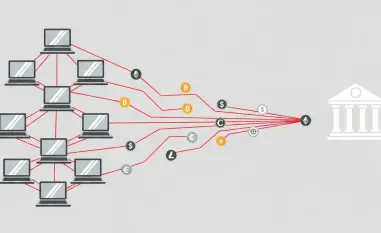Recent findings by Canada’s Communications Security Establishment (CSE) have shed light on the cyber activities of hackers linked to Beijing, especially in critical U.S. infrastructure networks. The report from the CSE strongly indicates that these hackers are “very likely” infiltrating these networks to pre-position China for a potential conflict with the United States. This pre-positioning strategy involves establishing control over essential U.S. systems, which could be exploited in a major crisis or conflict, thus hindering the U.S. military response and causing societal panic.
Threat to Shared Infrastructure Networks
Cross-border Vulnerabilities
Given the close integration of infrastructure networks between the U.S. and Canada, such as in transportation, energy, and telecommunications, the threat from Beijing-linked hackers extends significantly northward. The CSE’s report emphasizes that any disruptive or destructive cyber activities against these interwoven North American infrastructures could have a profound impact on Canada due to their cross-border interoperability and interdependence. The intertwined nature of these systems means that a cyberattack designed to cripple U.S. infrastructure could inadvertently or deliberately disable critical Canadian systems as well. The interconnected electricity grids, for example, are vital to both countries, with power generation and distribution crossing national borders seamlessly. Any disruption in the U.S. could lead to cascading failures in Canada. Similarly, shared transportation systems like railways and airline networks are vulnerable to disruption, impacting both nations’ economies and day-to-day operations. The reliance on integrated telecommunications systems further complicates the situation, as a breach in U.S. communications infrastructure could compromise Canadian data and operations too. This shared vulnerability underscores the need for robust, coordinated cybersecurity measures between the two countries to mitigate these risks.
The Role of Volt Typhoon
Adding to the alarming nature of the findings, the report names a specific Beijing-linked hacking group, “Volt Typhoon,” as a primary actor in these pre-positioning operations. This group’s activities are seen as particularly troubling because the People’s Republic of China (PRC) has generally avoided engaging in disruptive or destructive cyber operations against critical infrastructure in the past. The transition to such aggressive tactics marks a significant escalation in China’s cyber capabilities and strategy. Over the past four years, 20 Canadian government networks have been compromised by PRC-linked hacking groups, demonstrating the persistent and pervasive nature of these cyber threats. Volt Typhoon appears to be positioning itself for a significant conflict, which raises serious concerns about the preparedness and resilience of U.S. and Canadian infrastructure. The group’s tactics involve not just passive surveillance but are strategically aimed at gaining control over essential systems. This could involve embedding malicious software that remains dormant until activated during a crisis. The potential to paralyze critical infrastructure at a moment’s notice suggests Volt Typhoon’s high level of sophistication and the strategic importance Beijing places on these cyber operations. The escalation in cyber aggression by PRC-linked hackers reinforces the critical need for heightened vigilance and stronger defensive measures in both countries.
Broader Cyber Threat Landscape
China’s Comprehensive Cyber Threat
The CSE report identifies the Chinese government as the most comprehensive cyber threat to Canada, characterized by a well-developed cyber program encompassing surveillance, espionage, and attack capabilities. State-sponsored actors from the PRC have consistently targeted a wide range of networks within Canada, including federal, provincial, territorial, municipal, and Indigenous systems. The primary objective of these attacks has been to collect valuable communications and sensitive information, thereby compromising national security and sovereignty. This highlights the extensive reach and ambitions of China’s cyber espionage efforts, demonstrating their capability to infiltrate and extract critical data from varied sources. Infiltration of government networks is a significant concern as it can lead to the exposure of highly sensitive information, including policy drafts, strategic plans, and classified communications. This not only puts Canada at risk but also impacts its allies and partners, given the interconnected nature of global intelligence-sharing networks. Moreover, the ability to siphon off communication data could provide the PRC with a strategic edge in various geopolitical and economic negotiations. The consistent targeting of Canadian networks underscores the importance of developing more resilient systems and enhancing cybersecurity protocols to deter these sophisticated cyber threats.
India’s Emerging Cyber Capabilities
While China remains the top cyber threat, the CSE report briefly touches on the emerging cyber capabilities of India. The recent assassination of Sikh independence activist Hardeep Singh Nijjar, allegedly linked to Indian government officials, has heightened tensions and drawn attention to India’s developing cyber capabilities. However, the CSE assesses that India’s current cyber threat is relatively limited compared to China’s extensive operations. Despite this, the report notes India’s ambition to develop a modern cyber program and its likely engagement in espionage activities targeting Canadian networks, driven by complex bilateral relations and political considerations. India’s cyber threat, while currently limited, poses a potential risk as the country continues to modernize its cyber capabilities. The evolving landscape of state-sponsored cyber threats suggests that India could increase its cyber activities, particularly in the fields of surveillance and espionage. This is especially relevant given the historical and political context between Canada and India. The growing sophistication of India’s cyber program indicates a future trajectory where it could become a more prominent actor, necessitating close monitoring and strategic adjustments to Canada’s cybersecurity policies. The report’s highlight of India’s emerging capabilities underlines the dynamic nature of cyber threats and the need for proactive measures to address them.
Conclusion
Recent intelligence from Canada’s Communications Security Establishment (CSE) has brought to light significant activity by hackers connected to Beijing, particularly targeting critical infrastructure networks within the United States. This report from the CSE underscores that these cyber intrusions are “very likely” initiated with the purpose of positioning China advantageously ahead of any potential conflict with the U.S. The essence of this strategy is to establish a foothold in key U.S. systems, potentially allowing China to disrupt these networks during a major crisis or conflict. Such control could severely hamper the U.S. military’s ability to respond effectively, as well as create widespread societal panic. These actions suggest a deliberate effort by Beijing to leverage cyber capabilities to undermine U.S. national security, focusing on critical infrastructure as a strategic vulnerability. The intent is clear: to gain an upper hand by compromising essential systems, thus crippling U.S. responses and inciting fear during times of heightened tensions or war.













